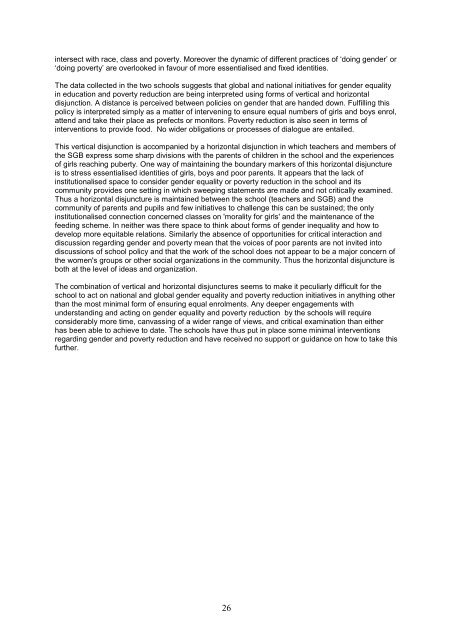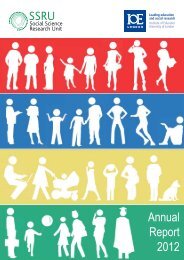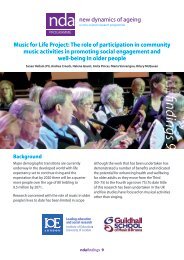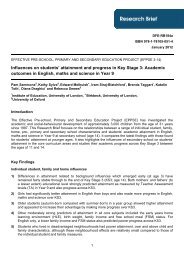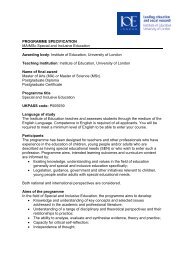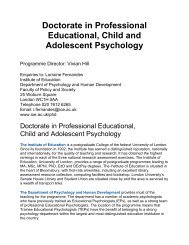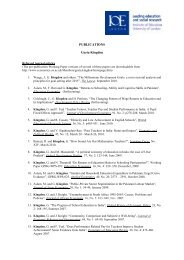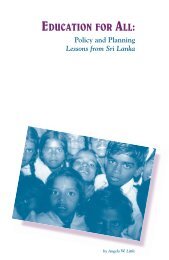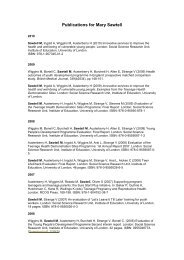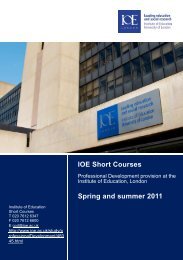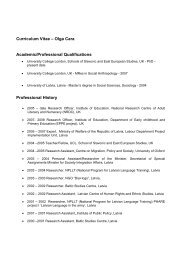Working paper 1 (pdf - Institute of Education, University of London
Working paper 1 (pdf - Institute of Education, University of London
Working paper 1 (pdf - Institute of Education, University of London
You also want an ePaper? Increase the reach of your titles
YUMPU automatically turns print PDFs into web optimized ePapers that Google loves.
intersect with race, class and poverty. Moreover the dynamic <strong>of</strong> different practices <strong>of</strong> „doing gender‟ or<br />
„doing poverty‟ are overlooked in favour <strong>of</strong> more essentialised and fixed identities.<br />
The data collected in the two schools suggests that global and national initiatives for gender equality<br />
in education and poverty reduction are being interpreted using forms <strong>of</strong> vertical and horizontal<br />
disjunction. A distance is perceived between policies on gender that are handed down. Fulfilling this<br />
policy is interpreted simply as a matter <strong>of</strong> intervening to ensure equal numbers <strong>of</strong> girls and boys enrol,<br />
attend and take their place as prefects or monitors. Poverty reduction is also seen in terms <strong>of</strong><br />
interventions to provide food. No wider obligations or processes <strong>of</strong> dialogue are entailed.<br />
This vertical disjunction is accompanied by a horizontal disjunction in which teachers and members <strong>of</strong><br />
the SGB express some sharp divisions with the parents <strong>of</strong> children in the school and the experiences<br />
<strong>of</strong> girls reaching puberty. One way <strong>of</strong> maintaining the boundary markers <strong>of</strong> this horizontal disjuncture<br />
is to stress essentialised identities <strong>of</strong> girls, boys and poor parents. It appears that the lack <strong>of</strong><br />
institutionalised space to consider gender equality or poverty reduction in the school and its<br />
community provides one setting in which sweeping statements are made and not critically examined.<br />
Thus a horizontal disjuncture is maintained between the school (teachers and SGB) and the<br />
community <strong>of</strong> parents and pupils and few initiatives to challenge this can be sustained; the only<br />
institutionalised connection concerned classes on 'morality for girls' and the maintenance <strong>of</strong> the<br />
feeding scheme. In neither was there space to think about forms <strong>of</strong> gender inequality and how to<br />
develop more equitable relations. Similarly the absence <strong>of</strong> opportunities for critical interaction and<br />
discussion regarding gender and poverty mean that the voices <strong>of</strong> poor parents are not invited into<br />
discussions <strong>of</strong> school policy and that the work <strong>of</strong> the school does not appear to be a major concern <strong>of</strong><br />
the women's groups or other social organizations in the community. Thus the horizontal disjuncture is<br />
both at the level <strong>of</strong> ideas and organization.<br />
The combination <strong>of</strong> vertical and horizontal disjunctures seems to make it peculiarly difficult for the<br />
school to act on national and global gender equality and poverty reduction initiatives in anything other<br />
than the most minimal form <strong>of</strong> ensuring equal enrolments. Any deeper engagements with<br />
understanding and acting on gender equality and poverty reduction by the schools will require<br />
considerably more time, canvassing <strong>of</strong> a wider range <strong>of</strong> views, and critical examination than either<br />
has been able to achieve to date. The schools have thus put in place some minimal interventions<br />
regarding gender and poverty reduction and have received no support or guidance on how to take this<br />
further.<br />
26


